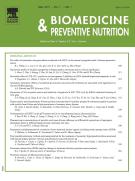Hepatoprotective and antioxidative effects of C-phycocyanin from Arthrospira maxima SAG 25780 in CCl4-induced hepatic damage rats - 06/06/12

 , P. Arulmurugan a, M.G. Rajaram a, K. Karuppasamy b, K.R. Jayappriyan a, R. Sundararaj c, N. Vijayanand d, R. Rengasamy a
, P. Arulmurugan a, M.G. Rajaram a, K. Karuppasamy b, K.R. Jayappriyan a, R. Sundararaj c, N. Vijayanand d, R. Rengasamy aAbstract |
The efficacy of C-phycocyanin obtained from Arthrospira maxima SAG 25780 was evaluated on the levels of lipid peroxidation, and antioxidant parameters as well as histopathological and immunohistochemical assessment in carbon tetrachloride (CCl4) induced liver damage in the male Wistar albino rats. The rats were injected by CCl4 intraperitoneal (50% CCl4, 0.5mg/kg body weight) that led to a marked increase in oxidative stress indicated by alterations in lipid peroxidation, enzymic and non-enzymic antioxidants. Treatment with C-phycocyanin (75mg/kg body weight) restored the above-mentioned alterations towards normalcy, highlighting the antioxidant potential of C-phycocyanin in mitigating the oxidative stress mediated damage produced during CCl4-induced male rats. The liver damage was further confirmed by histopathological and immunohistochemical studies. The present investigation strongly suggested that the C-phycocyanin protects CCl4-induced hepatotoxicity in Wistar rats.
Le texte complet de cet article est disponible en PDF.Keywords : C-phycocyanin, Histopathology, Immunohistochemistry, Carbon tetrachloride
Plan
Vol 2 - N° 2
P. 81-85 - avril 2012 Retour au numéroBienvenue sur EM-consulte, la référence des professionnels de santé.
L’accès au texte intégral de cet article nécessite un abonnement.
Déjà abonné à cette revue ?

